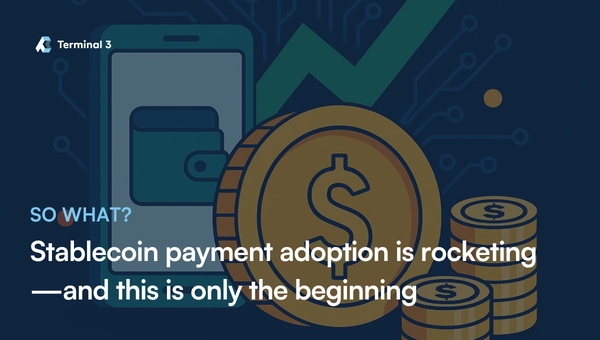The growing convergence between traditional payment and finance and Web3

GM,
This week we’re looking at the growing convergence between traditional finance and payments and the Web3 industry. This year alone, billions have been spent on acquisitions both ways and companies on both sides are likely to increasingly look like each other.
Let’s dive in!
Best,
What’s going on?
The year may be young but already we’ve seen huge deals between traditional and Web3 finance and payment companies suggesting that convergence between the two is accelerating.
It may have sounded crazy just a few years ago to imagine trading stocks, shares and cryptocurrencies side by side; or for a payment company to explore stablecoin-based transactions… and then spend over $1 billion to make it happen.
There’s often talk that Web3 doesn’t have broader adoption. The ever-increasing overlap between these two industries is one way that new technology will reach a larger audience.
SO WHAT?
1. Traditional finance players want a slice of Web3
The Web3 market entered a period of relative depression this year, after the price of Bitcoin and other cryptocurrencies sailed at the tail end of last year buoyed by the imminent arrival of Donald Trump as President.
So far, 2025 has been a ‘sell the news’ event—a popular trading phrase that essentially means the anticipation outweighed the reality. But the depressive cycle hasn’t stopped major tech players entering or deepening their presence in the Web3 space.
- Stripe completed its acquisition of Bridge, a platform that enables stablecoins for payments, for $1.1 billion in February
- Neobank Revolut launched a mobile app for its fledgling crypto business X in March
- Robinhood, the mobile stock trading platform, just added prediction markets (made famous by Web3) to its growing cryptocurrency offering
The acquisition figure for the Bridge deal did raise eyebrows, but none of these news developments are a surprise.
That’s because Web3 has a lot in common with trading, investing and financial services. It makes sense that Stripe is assessing how it can use stablecoins within its payment solutions, which take in the likes of Visa, Mastercard and other middlemen, not to mention the complexity of linking international bank accounts.
For Revolut, cryptocurrency trading expands its existing focus on public market investing. Its primary focus is to be a bank, but when you hold customers’ money for them, it makes sense to give them ways to put it to work—and it makes sense to (carefully) offer exposure to cryptocurrencies when you already have stock investing.
Robinhood, meanwhile, has offered cryptocurrency trading for some time—Robinhood Crypto launched in 2021—and it even offers more sophisticated wallet options for customers. Prediction markets have gained huge attention, not to mention revenue, so this is also a logical extension of its business. It’s worth noting that it is using a US-licensed (and non-crypto) prediction market partner in Kalshi in order to be compliant.
These companies are merely the tip of the iceberg. It is likely that all payment companies that aren’t already researching or investigating stablecoins publicly, are doing so privately. Platforms that offer stocks can see easy scope to introduce cryptocurrency trading, and those already in the space are exploring newer and more edgier features.
2. Web3 players want the legitimacy of traditional finance
This trend isn’t just traditional finance companies getting into Web3, it flows the other way, too. Kraken announced in March that it would fork out $1.5 billion to acquire NinjaTrader, a US-based futures trading platform for retail customers.
The logic is the same as the traditional players. Kraken is already serving millions of customers in the US who want to trade cryptocurrencies, now it can offer futures and derivatives services for traditional assets.
With NinjaTrader’s license, it is also poised to offer those services for cryptocurrency assets too. There’s also an international angle. Kraken plans to “accelerate” NinjaTrader’s expansion into the US, Europe and Australia which can also be used to expand its core business.
This deal comes as Kraken is rumored to be preparing its business for an IPO in the US, a move that would see it join Coinbase as the only other publicly traded US Web3 company. Plotting growth into more traditional trading markets, overseas territories and acquiring licenses is a major narrative to show investors its business can seriously develop.
License acquisition isn’t new, of course. Crypto.com, for example, made two acquisitions in 2021 in order to grab licenses to offer derivatives and futures products. A similar deal that closed last year gave it a green light for equities and equity options. Coinbase has made deals too, buying an institutional digital asset manager and SEC-registered investment adviser.
Reports this month suggested that Coinbase is in talks to buy crypto derivatives exchange Deribit for up to $5 billion to massively expand the services it offers.
Crypto.com has said repeatedly in public that it is a fintech company and not a cryptocurrency business. That may well sound like spin, but increasingly its peers are seeing the opportunity to offer more than just crypto trading in the US market.
3. Catalysts kick in
Overlap has always existed, but a number of catalysts may be behind this accelerating convergence including:
1. Regulatory clarity
The key ingredient here is likely to be the US SEC’s new focus on developing regulation for Web3 technology and concepts. To state the obvious, that means these technologies and features won’t land companies in trouble or don’t operate in a grey zone.
The fact that the market and prices aren’t flying shows that these companies are looking at these deals and launches purely in terms of tech and product, not simply FOMO.
2. Time
In the case of stablecoins, the concept is not new and a number of companies have spent years looking into the feasibility of stablecoins and distributed ledgers as payment rail alternatives. PayPal and Visa being two prime examples we’ve written about before.
Over the course of time, it makes sense that use cases have emerged and alliances have been formed between traditional payment companies and Web3 firms. It is still early, however, and whilst advances have been made and billions of dollars have been spent, we still haven’t seen the full potential yet.
3. Disruption
Technology can be a great leveler and the introduction of cutting-edge technology like AI could allow companies to iterate faster and develop products that can challenge incumbents in traditional markets. For one thing, traditional markets are aware and responding.
The Nasdaq, for instance, is moving away from traditional operating hours to a new schedule that would see it open for trading 24-hours a day on weekdays. That’s in direct response to the 24/7/365 nature of crypto trading markets, which never close and include traders from all corners of the globe.
We’ll be keeping an eye on the convergence of traditional and digital finance and payments this year. Not only for new deals, but new services and use cases that hit the market and change the user experience.
News bytes
Japan's second-largest bank, SMBC, is planning to launch a stablecoin, according to media reports
Circle, which issues USDC—the world’s second-largest stablecoin—filed for a US IPO with plenty of interesting data:
The company reported revenue and reserve income of $1.68 billion for last year, compared with $1.45 billion in 2023. Net income from continuing operations was nearly $157 million in 2024 versus $271.5 million in the previous year.
FTX will start paying its main creditors at the end of May using a cash hoard of $11.4 billion the company has collected since its shut down
BNB, the token for the Binance blockchain, could be the next US ETF after investment manager VanEck completed a key filing to start the process
The SEC may have made positive noises towards Web3, but a top US politician has said there is no consensus to allow stablecoins to generate yield for users, dismissing the pleas from industry leaders like Coinbase CEO Brian Armstrong
The Japanese Financial Services Agency plans to revise its law to formally position crypto assets as financial products, which could include new "insider trading" regulations
That’s all for this week!
Share your feedback, questions or requests via email to: sowhat@terminal3.io




